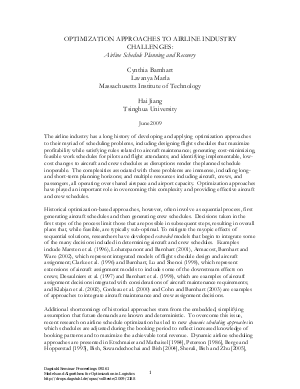OPTIMIZATION APPROACHES TO AIRLINE INDUSTRY CHALLENGES: Airline Schedule Planning and Recovery
Authors Cynthia Barnhart, Hai Jiang, Lavanya Marla
-
Part of:
Volume:
Dagstuhl Seminar Proceedings, Volume 9261
Part of: Series: Dagstuhl Seminar Proceedings (DagSemProc) - License:
 Creative Commons Attribution 4.0 International license
Creative Commons Attribution 4.0 International license
- Publication Date: 2009-10-02
File

PDF
DagSemProc.09261.20.pdf
- Filesize: 81 kB
- 3 pages
Document Identifiers
Subject Classification
Keywords
- Airline aircraft and crew optimization
- robust scheduling
- dynamic scheduling
Metrics
- Access Statistics
-
Total Accesses (updated on a weekly basis)
0PDF Downloads0Metadata Views
Abstract
The airline industry has a long history of developing and applying optimization approaches to their myriad of scheduling problems. These problems have several challenging characteristics, the two most challenging of which include: 1) they span long- and short-term horizons, from strategic planning of flight schedules operated several months into the future, to real-time operations in which strategies must be developed and implemented immediately to recover scheduled operations from disruptions; and 2) they include multiple resources that must be coordinated, such as aircraft, crews, and passengers. While optimization approaches have been essential to the airline industry and effective in developing aircraft and crew schedules, historical models and approaches often fail to capture the complexity of airline operations. For example, approaches, often by necessity, involve a sequential, rather than an integrated process to develop schedules for aircraft and crews, and moreover, the process involves simplifying assumptions, including that future demands are known and deterministic, and that schedules are operated as planned. In more recent research on airline schedule optimization, advances have led to new schedule optimization models and approaches that more accurately reflect reality. As described in this presentation, the most notable contributions to these advances include: 1. Integrated Aircraft and Crew Schedule Optimization Approaches in which some of the aircraft and crew schedule decisions previously taken sequentially are integrated, moving closer to producing globally optimal schedules; 2. Dynamic Scheduling Approaches in which schedules are adjusted during the passenger booking period to reflect increased knowledge of booking patterns and to increase the schedule’s associated total revenue; and 3. Robust Optimization Approaches in which the stochastic nature of airline operations is modeled and realized schedule performance is optimized.
Cite As Get BibTex
Cynthia Barnhart, Hai Jiang, and Lavanya Marla. OPTIMIZATION APPROACHES TO AIRLINE INDUSTRY CHALLENGES: Airline Schedule Planning and Recovery. In Models and Algorithms for Optimization in Logistics. Dagstuhl Seminar Proceedings, Volume 9261, pp. 1-3, Schloss Dagstuhl – Leibniz-Zentrum für Informatik (2009)
https://doi.org/10.4230/DagSemProc.09261.20
BibTex
@InProceedings{barnhart_et_al:DagSemProc.09261.20,
author = {Barnhart, Cynthia and Jiang, Hai and Marla, Lavanya},
title = {{OPTIMIZATION APPROACHES TO AIRLINE INDUSTRY CHALLENGES: Airline Schedule Planning and Recovery}},
booktitle = {Models and Algorithms for Optimization in Logistics},
pages = {1--3},
series = {Dagstuhl Seminar Proceedings (DagSemProc)},
ISSN = {1862-4405},
year = {2009},
volume = {9261},
editor = {Cynthia Barnhart and Uwe Clausen and Ulrich Lauther and Rolf H. M\"{o}hring},
publisher = {Schloss Dagstuhl -- Leibniz-Zentrum f{\"u}r Informatik},
address = {Dagstuhl, Germany},
URL = {https://drops.dagstuhl.de/entities/document/10.4230/DagSemProc.09261.20},
URN = {urn:nbn:de:0030-drops-21880},
doi = {10.4230/DagSemProc.09261.20},
annote = {Keywords: Airline aircraft and crew optimization, robust scheduling, dynamic scheduling}
}
